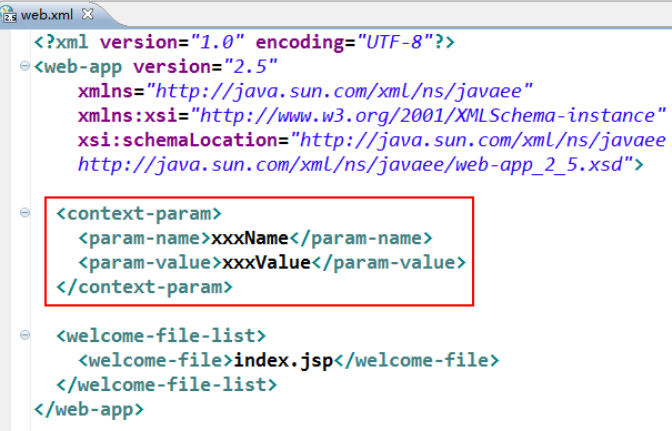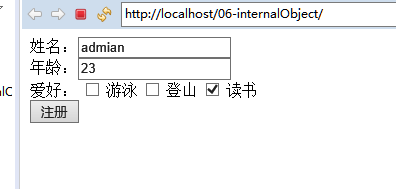EL 内置对象
就像 JSP 的 Java 代码块及表达式块中可以使用九个内置对象一样,EL 表达式中,同样也存在有内置对象,并且存在 11 个内置对象。
常用的内置对象,除了前面使用过的四个域属性空间相关的内置对象外,还有如下几个。
(5 ) pageContext
该 pageContext 与 JSP 内置对象中的 pageContext 是同一个对象。
通过该对象,可以获取到 request、response、session、servletContext、servletConfig 等对象。
注意这些对象在 EL中不是内置对象,这些对象只能通过 pageContext 获取。
在 EL 中直接${pageContext.request}即可获取 request 对象。当然,其底层实际调用的是pageContext.getRequest()方法。
同理,也可以通过类似方式获取到其它对象。
在这些获取的对象中,有一个是实际工程中最常用的:${pageContext.request.contextPath} ,用于获取当前项目的发布到服务器的名称。一般会用在 JSP 页面的路径前.

先写一个
index.jsp
1 <form action="${pageContext.request.contextPath }/RegisterServlet" method="POST"> 2 姓名:<input type="text" name="name"/><br> 3 年龄:<input type="text" name="age"/><br> 4 爱好: 5 <input type="checkbox" name="hobby" value="swimming"/> 游泳 6 <input type="checkbox" name="hobby" value="climbing"/> 登山 7 <input type="checkbox" name="hobby" value="reading"/> 读书 8 <br> 9 <input type="submit" value="注册"/> 10 </form>
RegisterServlet.java
1 package com.bjpowernode.servlet; 2 3 import java.io.IOException; 4 import javax.servlet.ServletException; 5 import javax.servlet.http.HttpServlet; 6 import javax.servlet.http.HttpServletRequest; 7 import javax.servlet.http.HttpServletResponse; 8 9 public class RegisterServlet extends HttpServlet { 10 protected void doPost(HttpServletRequest request, HttpServletResponse response) 11 throws ServletException, IOException { 12 System.out.println("================="); 13 } 14 15 }
在 EL 的 11 个内置对象中,除了 pageContext 外,其它 10 个内置对象,其类型均为java.util.Map 类型
(6 ) param
在 EL 中通过 ${param.参数名}可获取到请求中指定参数名的值。 例如,提交的请求为:

在 JSP 页面中通过如下方式,可获取到 name 参数的值为 abc

(7 ) paramValues
若提交的请求中同一参数具有多个值,则可通过 ${paramValues.参数名[索引]} 获取到指定索引号的该参数值。例如,提交的请求为:

在 JSP 页面中获取方式如下:

在浏览器中显示内容如下

(8 ) initParam
在EL中通过使用 ${initParam.初始化参数名} 可以获取到指定的初始化参数的值。
例如,在 web.xml 中定义了初始化参数 xxxName。

在 JSP 的 EL 中可访问该初始化参数:

示例:
index.jsp
1 <%@ page language="java" contentType="text/html; charset=UTF-8"
2 pageEncoding="UTF-8"%>
3 <!DOCTYPE html PUBLIC "-//W3C//DTD HTML 4.01 Transitional//EN" "http://www.w3.org/TR/html4/loose.dtd">
4 <html>
5 <head>
6 <meta http-equiv="Content-Type" content="text/html; charset=UTF-8">
7 <title>Insert title here</title>
8 </head>
9 <body>
10 <form action="${pageContext.request.contextPath }/show.jsp" method="POST">
11 姓名:<input type="text" name="name"/><br>
12 年龄:<input type="text" name="age"/><br>
13 爱好:
14 <input type="checkbox" name="hobby" value="swimming"/> 游泳
15 <input type="checkbox" name="hobby" value="climbing"/> 登山
16 <input type="checkbox" name="hobby" value="reading"/> 读书
17 <br>
18 <input type="submit" value="注册"/>
19 </form>
20 </body>
21 </html>
web.xml
1 <context-param>
2 <param-name>company</param-name>
3 <param-value>bjpowernode</param-value>
4 </context-param>
5 <context-param>
6 <param-name>address</param-name>
7 <param-value>中国北京</param-value>
8 </context-param>
show.jsp
1 <%@ page language="java" contentType="text/html; charset=UTF-8"
2 pageEncoding="UTF-8"%>
3 <!DOCTYPE html PUBLIC "-//W3C//DTD HTML 4.01 Transitional//EN" "http://www.w3.org/TR/html4/loose.dtd">
4 <html>
5 <head>
6 <meta http-equiv="Content-Type" content="text/html; charset=UTF-8">
7 <title>Insert title here</title>
8 </head>
9 <body>
10 <!-- 获取请求中的指定参数值,其底层实际调用的是:
11 request.getParameter()
12 -->
13 name = ${param.name } <br>
14 age = ${param.age } <br>
15
16 <!-- 获取请求中的指定参数的所有值,其底层实际调用的是:
17 request.getParameterValues()
18 -->
19 hobby[0] = ${paramValues.hobby[0] } <br>
20 hobby[1] = ${paramValues.hobby[1] } <br>
21 hobby[2] = ${paramValues.hobby[2] } <br>
22
23 <!-- 获取初始化参数,其底层实际调用的是:
24 servletContext.getInitParameter()
25 -->
26 company = ${initParam.company } <br>
27 address = ${initParam.address } <br>
28
29 </body>
30 </html>

